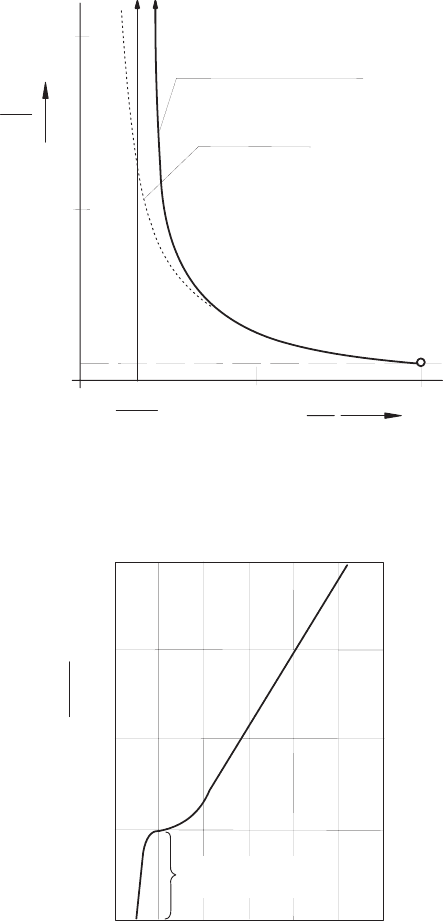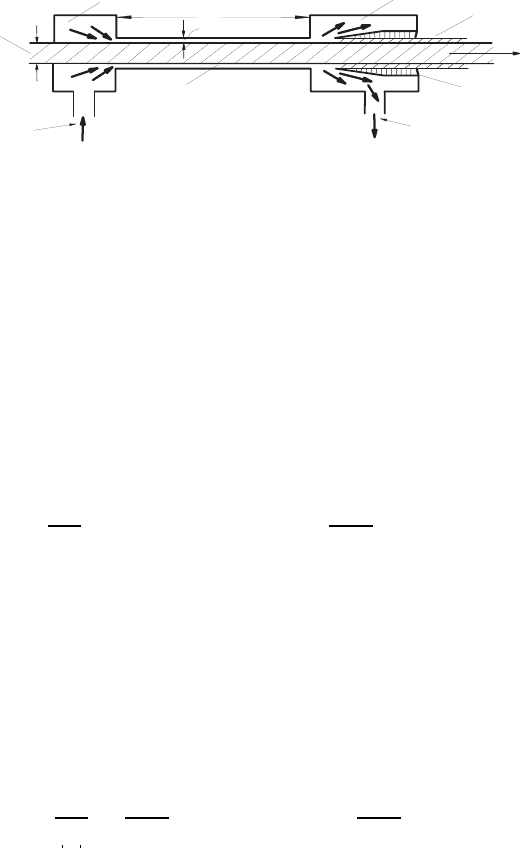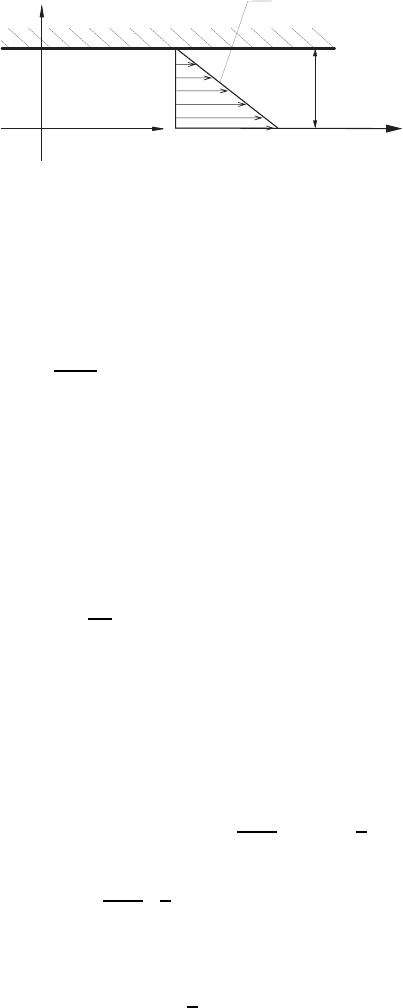Durst F. Fluid Mechanics: An Introduction to the Theory of Fluid Flows
Подождите немного. Документ загружается.


12.7 Normal Compression Shock (Rankine–Hugoniot Equation) 359
v
v
B
A
p
p
B
A
20
10
0
00.5
1.0
x - 1
x + 1
Isentropic flow
Rankine-Hugoniot shock
Fig. 12.16 Changes of state for vertical compression shock
0
1.0 2.0 3.0 4.0 5.0 6.0
3.0
2.0
1.0
0
-1.0
M
A
S
A
S
B
R
Normal shocks
are impossible
−
Fig. 12.17 Change of entropy as a result of vertical compression shocks in an ideal
gas with κ =1.4

360 12 Introduction to Gas Dynamics
Figure 12.16 shows further that the fluid is compressed when it is mov-
ing through the compression shock. The pressure, density and temperature
increase on passing through the compression shock, i.e.
P
B
P
A
≥ 1;
ρ
B
ρ
A
≥ 1; and
T
B
T
A
≥ 1
When considering the difference s
B
− s
A
, using (12.46), it is evident (see
Fig. 12.17) that s
B
− s
A
can only be larger than zero for M
A
≥ 1. This
expresses that dilution shocks cannot occur in ideal gases, as they are not
permitted by the second law of thermodynamics, which demands s
B
−s
A
≥ 0.
In this section only an introduction into gas dynamics was given providing
treatments of compressible flows in a manner also applied in refs. [12.1] and
[12.2] as well as in [12.4] to [12.6]. More advanced treatments are provided in
[12.3].
References
12.1. Boˇsnjakovi´c, F., Technische Thermodynamik I, Verlag von Theodor Steinkopff,
Dresden, Leipzig, 1960.
12.2. Currie, I.G., Fundamental Mechanics of Fluids, McGraw-Hill, New York, 1974.
12.3. Oswatitsch, K., Gasdynamik, Springer, Berlin Heidelberg New York Vienna,
1952.
12.4. Yuan, S.W., Foundations of Fluid Mechanics, Prentice-Hall, Englewood Cliffs,
NJ, 1971.
12.5. Becker, E., Technische Thermodynamik, Teubner Studienbuecher, Mechanik,
Stuttgart, 1985.
12.6. Spurk, J.H., Stroemungslehre, Springer, Berlin, Heidelberg, New York, 4. Aufl.,
1996.
Chapter 13
Stationary, One-Dimensional Fluid Flows
of Incompressible, Viscous Fluids
13.1 General Considerations
In this chapter, flows of viscous fluids (µ = 0) are considered which are
stationary and two-dimensional. They are assumed to occur in fluids of con-
stant density and, in addition, the fluid is assumed to be fully developed in
the flow direction. The simplified equations determining this class of flow can
be derived from the general equations of fluid mechanics and the resultant
equations are basically one-dimensional. They are, moreover, for a number of
boundary conditions, accessible to analytical solutions and thus well suited
for students of natural and engineering sciences to provide to them an intro-
duction into fluid mechanics of viscous fluids. The basic knowledge gained
by studying these fluid flows can then be deepened in specialized lectures.
In this way, the knowledge of how flows of viscous fluids behaves in one-
dimensional flow cases can be extended and used for the solution of practical
flow problems.
As shown below, the problems discussed in this chapter can be tackled by
analytical solutions. Hence their properties with regard to the physics of fluid
flows can be described with a few terms of the Navier–Stokes equations and
solutions become possible due to the existence of simple boundary conditions.
In addition, it is assumed that stationarity exists for all flow quantities and
that fluids with a constant density are treated, i.e. fluids with ρ = constant.
This property holds not only for thermodynamically ideal liquids but also,
as shown in Sect. 12.1, for thermodynamically ideal gases when they flow at
moderate velocities.
Simple considerations show that gas flows with Mach numbers Ma ≤ 0.2
can be treated as incompressible with a precision which is sufficient for
practical application, i.e. gas flows at low Mach numbers can be treated
as fluids of constant density. For such fluids, the basic equations in the
form stated below hold, for Newtonian media when τ
ij
is introduced as
follows:
361

362 13 Incompressible Fluid Flows
τ
ij
= −µ
∂U
j
∂x
i
+
∂U
i
∂x
j
+
2
3
δ
ij
µ
∂U
k
∂x
k
=0 because
ρ=constant
. (13.1)
• Continuity equation:
∂U
1
∂x
1
+
∂U
2
∂x
2
+
∂U
3
∂x
3
=0. (13.2)
• Momentum equations:
– x
1
-component:
ρ
∂U
1
∂t
+ U
1
∂U
1
∂x
1
+ U
2
∂U
1
∂x
2
+ U
3
∂U
1
∂x
3
= −
∂P
∂x
1
+ µ
∂
2
U
1
∂x
2
1
+
∂
2
U
1
∂x
2
2
+
∂
2
U
1
∂x
2
3
+ ρg
1
. (13.3)
– x
2
-component:
ρ
∂U
2
∂t
+ U
1
∂U
2
∂x
1
+ U
2
∂U
2
∂x
2
+ U
3
∂U
2
∂x
3
= −
∂P
∂x
2
+ µ
∂
2
U
2
∂x
2
1
+
∂
2
U
2
∂x
2
2
+
∂
2
U
2
∂x
2
3
+ ρg
2
. (13.4)
– x
3
-component:
ρ
∂U
3
∂t
+ U
1
∂U
3
∂x
1
+ U
2
∂U
3
∂x
2
+ U
3
∂U
3
∂x
3
= −
∂P
∂x
3
+ µ
∂
2
U
3
∂x
2
1
+
∂
2
U
3
∂x
2
2
+
∂
2
U
3
∂x
2
3
+ ρg
3
. (13.5)
13.1.1 Plane Fluid Flows
As a further simplification for the subsequent considerations, the flow field
is assumed to be two-dimensional, i.e. for all quantities of the velocity and
pressure fields [∂(···)/∂x
3
] = 0 can be introduced. It is further assumed that
in the x
3
direction there is no flow component or that it is always possible
to introduce a coordinate system in such a way that only in the directions
of the two coordinate axes x
1
and x
2
do velocity components occur. Thus
one obtains the final equations for two-dimensional and two-directional flow
problems, which are employed in the following analytical solutions:
∂U
1
∂x
1
+
∂U
2
∂x
2
=0, (13.6)
ρ
∂U
1
∂t
+ U
1
∂U
1
∂x
1
+ U
2
∂U
1
∂x
2
= −
∂P
∂x
1
+ µ
∂
2
U
1
∂x
2
1
+
∂
2
U
1
∂x
2
2
+ ρg
1
, (13.7)
ρ
∂U
2
∂t
+ U
1
∂U
2
∂x
1
+ U
2
∂U
2
∂x
2
= −
∂P
∂x
2
+ µ
∂
2
U
2
∂x
2
1
+
∂
2
U
2
∂x
2
2
+ ρg
2
. (13.8)

13.1 General Considerations 363
The above equations are employed in subsequent sections for analytical com-
putations of fluid flows. It is assumed here that the flow causing effects are
known and that they fulfil the assumptions made to yield the above-stated
simplified form of the basic equations, i.e. (13.6)–(13.8).
Further restrictions which are made concerning the subsequently treated
flow problems should be mentioned with regard to the boundary conditions.
It is assumed that these boundary conditions are known and that they fulfil
the condition of stationarity, i.e. temporal changes do not occur. Because
of another restriction in the following considerations, only solutions of the
above equations are listed which are laminar. The perturbations acting on
fluid flows in practice constitute, in general, boundary conditions that depend
on time. Moreover, the disturbances have to be considered as unknown. Their
effects on flows are therefore not treated in the subsequent considerations in
this section.
13.1.2 Cylindrical Fluid Flows
For a large number of flow problems, boundary conditions exist which
originate from axi-symmetric flow geometries and which can be introduced
more easily into solutions of the basic equations of fluid mechanics, when
these equations are written in cylindrical coordinates. To provide these
equations, ρ = constant and µ = constant are also assumed.
• Continuity equation:
∂ρ
∂t
+ ρ
1
r
∂
∂r
(rU
r
)+
1
r
∂
∂ϕ
(U
ϕ
)+
∂
∂z
(U
z
)
=0. (13.9)
• Momentum equations:
– r-component:
ρ
3
∂U
r
∂t
+ U
r
∂U
r
∂r
+
U
ϕ
r
∂U
r
∂ϕ
−
U
2
ϕ
r
+ U
z
∂U
r
∂z
4
= −
∂P
∂r
+ µ
∂
∂r
1
r
∂(rU
r
)
∂r
+
1
r
2
∂
2
U
r
∂ϕ
2
−
2
r
2
∂U
ϕ
∂ϕ
+
∂
2
U
r
∂z
2
+ ρg
r
.
(13.10)
– ϕ-component:
ρ
∂U
ϕ
∂t
+ U
r
∂U
ϕ
∂r
+
U
ϕ
r
∂U
ϕ
∂ϕ
+
U
r
U
ϕ
r
+ U
z
∂U
ϕ
∂z
= −
1
r
∂P
∂ϕ
+µ
∂
∂r
1
r
∂(rU
ϕ
)
∂r
+
1
r
2
∂
2
U
ϕ
∂ϕ
2
+
2
r
2
∂U
r
∂ϕ
+
∂
2
U
ϕ
∂z
2
+ ρg
ϕ
.
(13.11)

364 13 Incompressible Fluid Flows
– z-component:
ρ
∂U
z
∂t
+ U
r
∂U
z
∂r
+
U
ϕ
r
∂U
z
∂ϕ
+ U
z
∂U
z
∂z
= −
∂P
∂z
+ µ
1
r
∂
∂r
r
∂U
z
∂r
+
1
r
2
∂
2
U
z
∂ϕ
2
+
∂
2
U
z
∂z
2
+ ρg
z
. (13.12)
For stationary, incompressible (ρ = constant) fluid flows of Newtonian
fluids, assuming axi-symmetry ∂(···)/∂ϕ =0andU
ϕ
= 0, one can obtain
the following final equations:
1
r
∂(rU
r
)
∂r
+
∂U
z
∂z
=0, (13.13)
ρ
U
r
∂U
r
∂r
+ U
z
∂U
r
∂z
= −
∂P
∂r
+ µ
∂
∂r
1
r
∂(rU
r
)
∂r
+
∂
2
U
r
∂z
2
+ ρg
r
, (13.14)
ρ
U
r
∂U
z
∂r
+ U
z
∂U
z
∂z
= −
∂P
∂z
+ µ
1
r
∂
∂r
r
∂U
z
∂r
+
∂
2
U
z
∂z
2
+ ρg
z
. (13.15)
These equations can be employed for solutions of fluid flow problems for
stationary axially symmetric fluid flows and for U
ϕ
=0.
13.2 Derivations of the Basic Equations
for Fully Developed Fluid Flows
13.2.1 Plane Fluid Flows
The basic equations for stationary, two-dimensional and fully developed fluid
flows can be derived from the equations for incompressible Newtonian media
on the assumption that the resulting fluid flow in the x
1
direction fulfils the
following relationships:
∂U
1
∂x
1
=0 and
∂U
2
∂x
2
=0. (13.16)
Thus the continuity equation is reduced to:
∂U
1
∂x
1
=0
+
∂U
2
∂x
2
=0 ;
∂U
2
∂x
2
= 0 and therefore U
2
= f(x
1
). (13.17)
Based on the assumption of a fully developed fluid flow, the relationships
(13.16) hold and from (13.17) we can derive:

13.2 Derivations of the Basic Equations 365
U
2
= constant U
2
=0
U
2
= 0 holds for fluid flows with
impermeable walls
,
(13.18)
i.e. stationary, incompressible and internal flows are unidirectional. They flow
only in the x
1
direction, i.e. only one U
1
component of the flow field exists.
This is a statement for the flow field that was obtained from the continuity
equation for fluid flows which are fully developed in the flow direction x
1
.The
momentum equations are simplified for this class of fluid flows as follows:
x
1
direction:
0=−
∂P
∂x
1
+ µ
∂
2
U
1
∂x
2
2
+ ρg
1
. (13.19)
x
2
direction:
0=−
∂P
∂x
2
+ ρg
2
. (13.20)
From (13.20), one obtains a general solution for the pressure field:
P = ρg
2
x
2
+ Π(x
1
). (13.21)
The pressure field P (x
1
,x
2
) comprises an externally imposed pressure, Π(x
1
),
which can be applied along the x
1
axis. The implementation of Π(x
1
) usually
takes place in practice with pumps and blowers. On introducing this general
pressure relationship into the momentum equation x
1
,takingU
1
(x
2
)into
consideration, one obtains:
0=−
dΠ
dx
1
+ µ
d
2
U
1
dx
2
2
+ ρg
1
, (13.22)
i.e. a differential equation for the unknown flow field U
1
(x
2
). This is the basic
equation which holds for incompressible, stationary and one-dimensional, i.e.
fully developed, fluid flows, if the flow medium has Newtonian properties and
the fluid can be regarded as incompressible and the viscosity as constant.
Physically, the equation can be interpreted in such a way that the pressure
gradient imposed externally in the x
1
direction counteracts the viscosity and
mass forces of the flow field
dΠ
dx
1
= µ
d
2
U
1
dx
2
2
+ ρg
1
. (13.23)
Here it is important that the pressure gradient, in accordance with (13.21),
can assume any externally imposed value, which for the flow problems treated
here must depend only on x
1
. Considering however, (13.18), and admitting
only constant mass forces, i.e. g
1
= constant, the right-hand side of (13.22) is
a function only of x
2
. Thus the pressure gradient in the x
1
direction assumes
a constant value in the case of stationary, incompressible and one-dimensional
fluid flows.

366 13 Incompressible Fluid Flows
13.2.2 Cylindrical Fluid Flows
Analogous to the above derivations of plane fluid flows, the derivations of
the basic equations for stationary, one-dimensional fluid flows can be made
for axi-symmetric flow cases also. For the following derivation, it is assumed
that in the z direction the fluid flow is fully developed, i.e. all derivatives of
the velocity components are zero in the z direction, as stated below
∂U
r
∂z
=0,
∂U
z
∂z
=0. (13.24)
With these assumptions, one obtains from the continuity equation:
∂
∂r
(rU
r
)=0 ; ρrU
r
= constant (13.25)
and because of the assumption of impermeable walls for the fluid (see (13.18))
one obtains:
U
r
=0
for the presence of impermeable walls
for the considered fluid flow
(13.26)
and thus the momentum equations hold:
0=−
∂P
∂r
+ ρg
r
. (13.27)
0=−
∂P
∂z
+ µ
1
r
∂
∂r
r
∂U
z
∂r
+ ρg
z
(13.28)
by integration of:
P (r, z)=ρg
z
r + Π(z), i.e.
∂P
∂z
=
dΠ
dz
. (13.29)
Finally, the above derivations result in:
0=−
dΠ
dz
+ µ
1
r
∂
∂r
r
∂U
z
∂r
+ ρg
z
. (13.30)
This last equation represents the conditional equation for the velocity field,
which has to be employed for solutions of one-dimensional (fully developed)
flow problems in axi-symmetric geometries.
13.3 Plane Couette Flow
In chemical process engineering, it is common practice, e.g. when coating
sheet metals, foils, plates, etc., to employ coating systems of the kind shown
in Fig. 13.1. This figure shows that the actual material to be coated is moved

13.3 Plane Couette Flow 367
L
D
2d
Outlet chamber
Coated layer
Outlet for
stripped fluid
Prechamber
Substrate to
be coated
Coating fluid
supply
Couette flow
Device to
stripp fluid
Q
z
Q
a
Fig. 13.1 Schematic representation of a coating system
through a pre-chamber filled with the coating fluid. From there the material
enters a channel with plane parallel walls that end in a fluid collecting cham-
ber, where the coating thickness is brought to the required final value by
scrubbers installed on both sides. The wiped off coating material is collected
in the discharge chamber and is fed back through a discharge pipe to the
coating fluid supply system.
The flow forming in the slots between the pre-chamber and the discharge
chamber, after a certain distance from the inlet, is called Couette flow. It is
characterized by the fact that no pressure gradients are used for driving the
flow, i.e. for Couette flow the following holds:
dΠ
dx
1
= 0 and therefore 0 = µ
d
2
U
1
dx
2
2
+ ρg
1
. (13.31)
In the case of a horizontal flow direction with respect to the vertical direc-
tion of the field of gravity, no mass forces are active which could drive the
fluid flow, as the x
1
direction is vertical to the direction of the gravitational
acceleration, i.e. for the Couette flow in Fig. 13.1 the following holds:
g
1
=0. (13.32)
Thus the basic equation stated in Sect. 13.2 for plane flows is reduced to the
differential equation describing the Couette flow:
−
dΠ
dx
1
=0
+ µ
d
2
U
1
dx
2
2
+ ρg
1
=0
=0 =⇒
∂
2
U
1
∂x
2
2
=0. (13.33)
From the resulting equation for U
1
, i.e. from (13.33), it can be seen that
the velocity profile U
1
(x
2
) occurring in the slot is independent of the viscosity
of the coating fluid. Thus also the required quantity of coating material is
independent of the viscosity of the coating medium, a property which is often
regarded to be desirable for well-designed coating systems. The system thus
becomes equally applicable for all fluid properties and results in velocity
profiles that are independent of the fluid properties (Fig. 13.2).

368 13 Incompressible Fluid Flows
Velocity profile of
Couette flow
D
U
0
x
x
2
x
1
Fig. 13.2 Basic geometry of the upper slit in the coating system shown in Fig. 13.1
(width of the slit in the x
3
direction is B)
When considering that, for the assumptions made, the velocity U
1
can
depend on the coordinate x
2
only, the final equation can be written as follows:
d
2
U
1
dx
2
2
=0 ; U
1
= C
1
x
2
+ C
2
. (13.34)
Because of the boundary conditions existing due to the operation of the
coating system, the integration constants C
1
and C
2
result in values as shown
below
x
2
=0:U
1
= U
0
= C
1
0+C
2
; C
2
= U
0
,
x
2
= D : U
1
=0=C
1
D + C
2
; C
1
= −U
0
/D.
(13.35)
Thus for the velocity profile one obtains
U
1
=
U
0
D
(D − x
2
)for0≤ x
2
≤ D. (13.36)
The required fluid volume of the coating material that has to be supplied
per unit time results from integration over the entire slot having the width
B in the x
3
direction, i.e. the integration has to be taken over both slot
openings, on the top and at the bottom of the substrate. For the system in
Fig. 13.1,
˙
Q
z
needed for coating results from the following integration:
˙
Q
z
=2
˙
Q =2B
D
#
0
U
1
dx
2
=2
U
0
B
D
Dx
2
−
1
2
x
2
2
D
0
(13.37)
=2
U
0
B
D
1
2
D
2
(13.38)
or as the final relationship:
˙
Q =
1
2
BU
0
D. (13.39)
